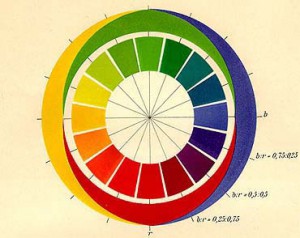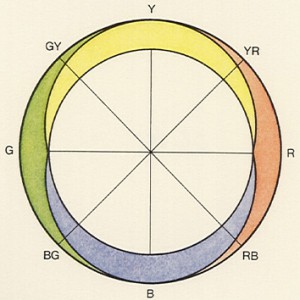I am going to explain to you Ewald Hering’s very exciting colour wheel chart containing of not 3 (RGB) but 4 primary colours (RGBY).
Hering was a German physiologist who specialised in colour perception. So basically how our eyes and brains work in relation to colour which we can call “the physiology of visual perception”
A problem that came up was the colour yellow; Helmholtz, another physicist who came op with the RGB model (the Young-Helmholtz theory) had stated that yellow came from a mixture of red and green (so there being 3 primary colours).

For hering this was not in line with the human experience because the sensation of yellow is very important and is not seen as a mixture of something else.
Instead of seeing complementary colours, like in the 3 primary colour wheel (RGB), Hering talked about opposing colours. Being; blue versus yellow, red versus green and black versus white.
So next to black and white there would be 4 colours which can occur without the “help” of another colour.
Every perception (what we see) is a mixture of the six basic sensations (so these four colours plus black and white) opposing each other and thus interacting.
Hering called these colours the “psychological primaries”.
Hering states that in the human eye thus brain there are three processes happening at the same time in order to see colour; the red-green, yellow-blue and black and white sensation. Later on I will explain why Hering also calls these sensations the “opposing pairs”.
(In his system, red green yellow and blue can be seen as primary colours. Anyone who is seeing orange can imagine it to be a mix of red en yellow. But no one looks at red, yellow or blue and sees it as a mixture of other colours.)
Hering wasn’t the first to talk about 4 primary colours. Before him so did Leonardo da Vinci. Only the arranging of the colours in a circular model was something Hering did. So the wheel is his invention with which he proved to have a real point.
The outer ring of the wheel shows how every primary colour has a warm and a cool side.
So warm red is red with a lot of yellow while cool red is more bluish
Warm yellow goes towards red and cool yellow towards green. Etc.
Each primary colour pair in the wheel has the same warm and cool side.
For example: Green and red have yellow for warm and blue for cold which makes them pairing as well as opposing.
Although having the same hot and cold sensations, the opposing colours in the weel cannot be part of each other.
– yellow can be kind of green or red but never blue
– green can be kind of blue or yellow but never red.
Complementary colours complete each other (like in the RGB wheel) but Hering’s opposing colours do the exact opposite.
A lot of us have learned in high school that there are three primary colours; red yellow and blue. The thing is actually that this 3 primary colour wheel is how to mix colours by knowing what colours complement each other and what colours generally look good together.
If we are talking about how we actually see colours, there are 4 primary colours!
So this is the big difference between the two wheels; the three colour wheel is about aesthetics while the 4 colour wheel (Hering’s) is about the psychological relationship we have towards colour.
You have to look at the 4 colour wheel like meters in your head. When the meter goes one way, there is more red, if it goes the other way you get green. If the meter stays in the middle you get zero so no colour (or actually a kind of greyish or brownish), same with yellow and blue.
Then at the same time you have a meter that, for example, goes from a reddish yellow to a greenish yellow and that goes from a yellowish green to a blueish green
And then there is also a meter that adds more or less black or white, also changing the colour.
R – 0 – G , so there is no greenish red
B – 0 – Y , so there is no yellowish blue
There is a greenish blue or a reddish blue (purple)
There is also a greenish yellow or a reddish yellow (orange)
Hering’s colour wheel is used a lot because it shows how the eye naturally perceives colour. So it’s less a bout just mixing paint or seeing how colors can be made in different media in what case you would need only three colours (RGB).
Instead, the wheel is better at showing what happens in the upper, brain level, and describing humans colour sensations.

